Text
It’s Familiar, All Too Familiar: Finding Conviction, Repentance, and Healing Through the McElroy Brothers
Have you ever experienced a piece of art, a book, a song, a television show, and felt like you belonged? What for you is that one created thing that makes you say “these are my people?” In Spring of 2017, I discovered a podcast called The Adventure Zone. The premise? Three brothers and their dad play Dungeons & Dragons. Since it was recommended by one of my favorite authors, Patrick Rothfuss, I made sure I jumped in at the very beginning with their 2014 debut episode of “Here There Be Gerblins.” The following week, I subscribed to the podcast My Brother, My Brother, and Me, also made by the same crew. Both MBMBaM and TAZ, among many other of other podcasts, are the creative endeavors of the McElroy Family, and most prominently the McElroy Brothers: Justin, Travis, and Griffin McElroy. Perhaps their most famous show, and the first produced by all three brothers, is My Brother, My Brother, and Me, a comedy-advice show. In their own words, it is an“advice show for the modern era.” Since 2010, the brothers have offered advice and insight to questions submitted by listeners, and to questions scoured from the depths of Yahoo! Answers. Each episode opens with the disclaimer that “the McElroy Brothers are not experts and their advice should never be followed.” I promise you, most days I do not laugh as hard as I do on Mondays when I listen to the latest episode. https://www.youtube.com/watch?v=anKCy1YNYKM Their Read the full article
1 note
·
View note
Text
What's On My "To See" List in 2020
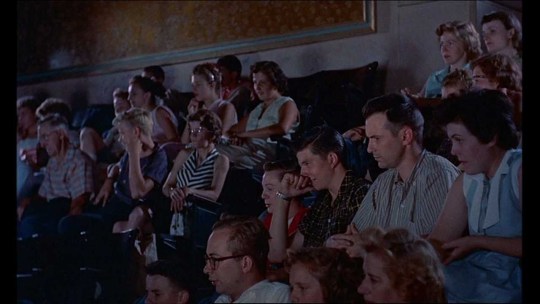
The Academy Awards are over. They were mediocre as far as production but Parasite won Best Picture and Bong Joon-ho won Best Directing which was all I desired. But a new year in cinema is upon us! Here's what I'm looking forward to in 2020! Wonder Woman 1984: I was genuinely surprised by the first film. It was a brief sign that maybe the tide was beginning to turn for DC. While I thought the third act was nothing special and perhaps even a little contrary to some of Wonder Woman's overarching themes, I'm still looking forward to Patty Jenkins' and Gal Gadot's second entry in the Wonder Woman saga. Between the retro '84 aesthetic and Kristen Wiig as Cheetah, I'll be surprised if this movie doesn't at least entertain for the majority of its run time. https://youtu.be/sfM7_JLk-84 The Invisible Man: I'm not sure what to expect from this movie. It has the potential to be a fascinating exploration about the trauma left in the wake of abusive relationships. The trailer certainly seems to indicate the same. However, the original work by H.G. Wells characterizes Griffin (the titular Invisible Man) as someone slowly becoming unhinged through his life experiences. Will this film be a bold take on abusive relationships, or will take a route similar to Joker where the villain is a tragic creation of his society and circumstances? I hope it is the former... https://www.youtube.com/watch?v=WO_FJdiY9dA The New Mutants: This movie is on here for no other reason than I've waited... and waited... and waited. I love the X-Men, despite their lackluster film history. This film has had production woes, their production company then changed hands from Fox to Disney, and the release date has been pushed back several times. But check out Wolfsbane and Magik. https://www.youtube.com/watch?v=q2QXoFZekNE The French Dispatch: So it's Wes Anderson... doing Wes Anderson stuff. I'll laugh, and reflect fondly on Bill Murray's versatility. https://www.youtube.com/watch?v=TcPk2p0Zaw4 Emma: I would not consider myself a fan of Jane Austen. I can appreciate Pride and Prejudice, but I never felt inclined to devour her bibliography the way I have Charles Dickens. But Emma looks very dry, and very funny. Bill Nighy looks like he's having a blast chewing scenery. https://www.youtube.com/watch?v=qsOwj0PR5Sk The King's Man: 2020 (like 2019, 2018, 2017...) is the the year for sequels, prequels, and spin offs. Franchises rule the day. I've written about The Kingsman franchise before on ThePilgrimGeek. I dig its style, its humor, and its deliberate yet lighthearted engagement with the super agent legacy of the likes of James Bond. The King's Man is a shoe-in for my 2020 list. Did I mention the villain is Rasputin!? https://www.youtube.com/watch?v=0pbLPOrTSsI Free Guy: Sometimes I'm interested in a flick because of its cast, despite a shaky premise. The trailer for Free Guy really says it all. Not something I'll run to the box office for on opening weekend, but a mid-week matinee? Sure. Also Taika Waititi has a role. Enough for me. https://www.youtube.com/watch?v=X2m-08cOAbc Bill & Ted Face the Music: There is not official trailer as of this posting. But there is a Super Bowl ad for Walmart. How much explanation does this sequel really need? https://www.youtube.com/watch?v=DE-WqZauGsc Wendy: Peter Pan is one of my favorite stories of all time. This interpretation has my curiosity. Captain Hook and his crew look less like pirates and more like lost fisherman, which is intriguing in its own right. https://www.youtube.com/watch?v=KKktQFFcXL0 Trolls World Tour: I did not see Trolls. I am still not sure I want to see Trolls. But Trolls World Tour? I am down. First and foremost, I want to see Trolls World Tour because my favorite podcasters and content creators trolled their way into the movie. Read that story from Vanity Fair here. That put the movie on my list right away because I love everything the McElroys touch, even bit cameos in movies with Justin Timberlake. I finally decided to watch the trailer this past week. Metal Trolls conquering the world. This would be a great opportunity to add Steel Panther's "Death To All But Metal" to the official sound track, but I have my doubts. Rock on. https://www.youtube.com/watch?v=SyTg7RIn-X8 What are you looking forward to in 2020? Which ones on this list look like garbage? Did I miss any important films in 2020? Comment below or shoot me an email! Read the full article
#BillandTedFacetheMusic#Emma#FreeGuy#TheFrenchDispatch#theinvisibleman#TheKingsMan#thenewmutants#TrollsWorldTour#Wendy#wonderwoman1984
0 notes
Text
"Life's a B*tch... then You Keep on Living"- Grace and Consequences in BoJack Horseman
Read the full article
1 note
·
View note
Text
Does the Joker Need an Origin Story? Minor Spoilers for Joker (Part the Second)
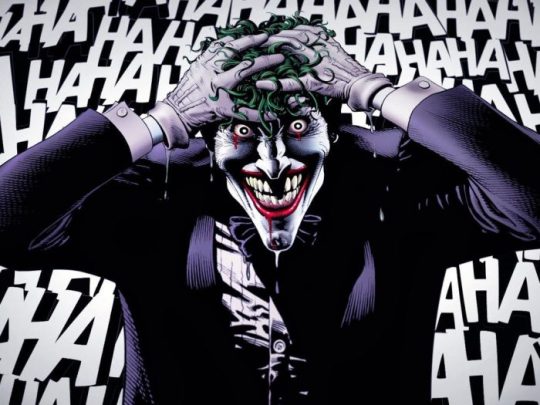
Within the Batman mythos, there has been an often returned to theme: Batman and the Joker are two interwoven pieces whose relationship is perpetual in its conflict, if not symbiotic in its necessity. As of late, particularly in the work of Scott Snyder, the Joker carries an infatuation with Batman, sometimes akin to that of an unrequited lover. The Joker and Batman are portrayed as two sides of the same coin and one does not exist without the other. Sometimes this is taken a step further: Batman and the Joker are so similar that Batman is always teetering on the edge of becoming the Joker. For a portrayal that is more on the nose, I direct you to The Batman Who Laughs, created by Snyder in the miniseries Dark Nights: Metal. The common theme often employed in recent history is that the Joker and Batman have more in common than they have in contrast. Those contrasts may be significant (Batman does not kill, and lives a by a code), but as the Joker tries to illustrate in Alan Moore’s The Killing Joke, Batman may only be one bad day from becoming his arch nemesis.
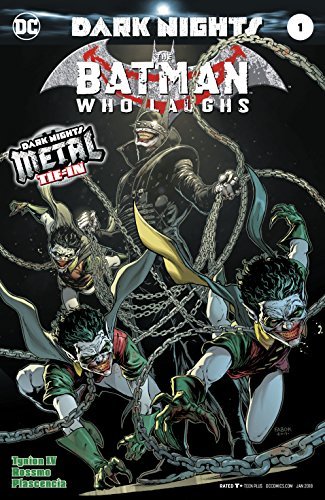
Yet what separates Batman from the Joker, and furthermore what separates all of the rogues’ gallery from the Clown Prince, is a well known and canonized backstory. The presence of an origin story is noticeably lacking in the Joker’s history. Several versions have been portrayed in comics, but the Joker of Batman canon confesses he does not remember his history the same way each time and prefers multiple choice. And here lies the rub with equating the Joker as Batman’s darkest potentiality. Batman is in many ways a noir hero. He is a protagonist pursuing righteousness in the midst of a corrupt world that feeds off of itself. In the spirit of films such as The Maltese Falcon or pulp characters such as The Shadow, the Dark Knight faces the forces of oppression and malevolence that plague Gotham City when no one else will. And Batman recognizes the humanity and loss of many of his own foes as well. Every foe Batman faces has an origin story that turns them into a tragic or sympathetic villain. Mr. Freeze is motivated by finding a cure for his chronically ill wife; Poison Ivy is an environmental scientist and activist turned mutated eco-terrorist; even the Riddler is sympathetic in the way his obsession with puzzles plays out in his pathology. None of these villains are ever killed by Batman because he fundamentally believes each of them has the potential for redemption. He is familiar with their origins. And each villain has traits that reflect Batman’s own. The Scarecrow weaponizes fear in the same fashion as Batman. Ras Al’Ghul acts with a certain sense of extreme, purifying justice.
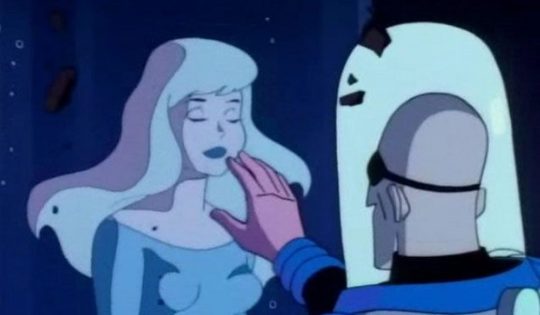
However, the Joker shares none of these traits. The Joker does not reflect a piece of Batman back on himself. He does not have an origin story that stirs up Batman’s sympathies. Instead, the Joker stands as the presence of meaningless chaos in Gotham City. The Joker remains a mysterious force rather than a humanized person. It is his role as an “agent of chaos” that pushes Batman’s convictions to its limits. He has no end goal or motivation like the rest of Batman’s rogues’ gallery. The Clown Prince of Crime is not even motivated by something as simple as wealth or conventional power. He only wants to rob the world of any structure. If he has any motivation, it has been his obsession with Batman (something developed more in recent history by Scott Snyder). The Joker is reminiscent of the character of Satan in the book of Job. In Alan Moore’s The Killing Joke, the Joker is the one who looks at Batman’s righteousness and says “All it takes is one bad day to reduce the sanest man alive to lunacy. That's how far the world is from where I am. Just one bad day.” It was with this framework in mind that I admit I walked into Todd Philips’ Joker with a some skepticism. It seems to me that the creation of an origin story for the Joker undermines the Joker’s very role in the Batman canon, and it is unwise to stir up too much sympathy for a villain whose sole role is to sow chaos. Imagine my apprehension when Philips appeared to go the extra mile in Joker by taking the Joker/Batman equation to an unprecedented extreme: the revelation that Arthur Fleck was Thomas Wayne’s illegitimate son. The Joker and Batman are brothers. It is a narrative choice that I’m sure made many fanboys squeal with anticipation. The greatest hero/villain relationship in modern history is now a horrible, secret family affair. In this rendition, the Joker is who he is because the esteemed Wayne family has a dark secret.
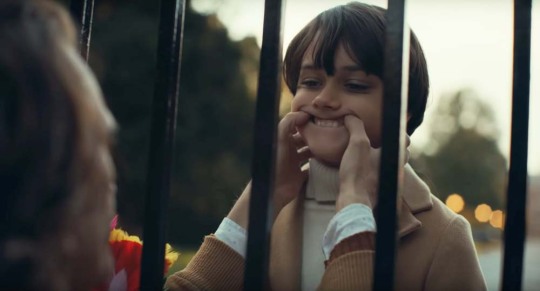
The revelation is muddied when Fleck steals his mother’s case file from Arkham Asylum, which confirms Thomas Wayne’s claim that Fleck’s mother is mentally ill, and that she adopted Fleck and exposed him to her abusive boyfriend. Penny Fleck then tells her son that Thomas Wayne used his money to fabricate the documents to cover up their affair. Who to believe? The thread of delusion and unreliable narration on the part of Arthur Fleck runs strong, but the question still remains. Are he and Batman brothers? In one of the film’s most eerie scenes, Arthur Fleck converses with a young Bruce Wayne through the front gate of Wayne Manor. Both are wearing yellow coats, and Fleck tries to make Bruce smile. He even going so far as to force smile on the boys face with his thumbs through the bars of the gate, which is a great allusion to the times Joker has painted smiling faces on Batman’s image throughout comic book history. In the end, the subject of Arthur Fleck’s parentage becomes irrelevant, even in his own mind. He murders his mother, then kills Murray the late night host (who holds some place as a father figure in Fleck’s mind). Joker is born of Arthur Fleck’s abandoning of any sense of origin. I wonder if Philips is aware that at the end of the day, the origin of the Joker is not the point of the character, but the chaos and mayhem he incites for sheer hedonistic pleasure.
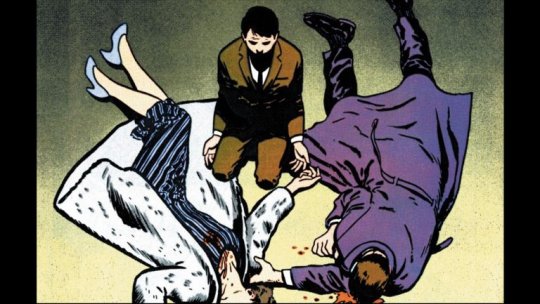
In the movie’s final scene, the Wayne family exits a movie theater in the midst of the riot. They are confronted in an alley by a man in a clown mask. In a moment comic book readers and movie goers have seen time and again, Thomas and Martha Wayne are shot dead, and their son Bruce is the only survivor. Joker ends with Batman’s origin story. Yet Philips chooses to take a degree of creative license with this iconic scene. It is comic book canon that the Waynes were murdered on their way home from a movie theater. In the canonical version of this story, the movie on the marquee is 1940’s The Mark of Zorro. However, in Joker the movie on the marquee is the 1981 comedy Zorro: The Gay Blade. Rather than showing the film that clearly influences the very imagery of Batman, Philips chooses to replace that reference with the farcical satire.
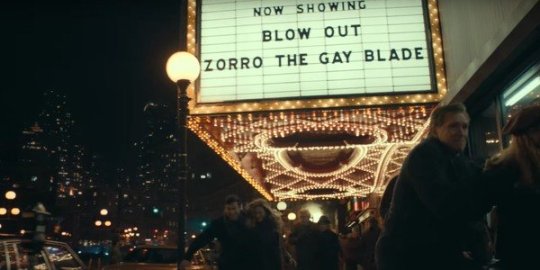
Are we, the audience, meant to realize we just sat through a farce? Did Todd Philips create some parody which asks “Does the Joker’s origin matter?” Feel free to tweet or comment below! Thank you for reading my two-part reflection on Todd Philips’ Joker. in case you missed it, here is Part 1! Have thoughts or reactions? Think I’m reading too much into the movie? Have any suggestions for “Minor Spoilers”? Leave it in the comments below or email me at [email protected]. Read the full article
1 note
·
View note
Text
Imperialism and Exceptionalism in the MCU: Major Spoilers for Avengers Endgame
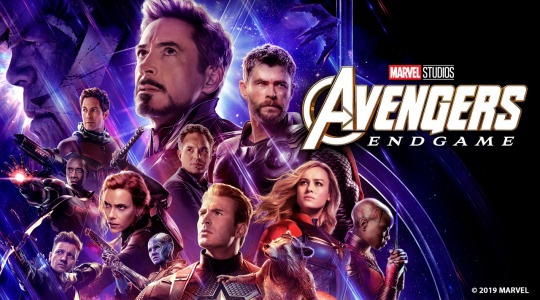
It’s Academy Award season! And once again, the Academy has limited blockbuster movie nominations to visual effects and similar production awards. Never mind the whole of the Marvel Cinematic Universe is an unprecedented feat of cinema. In honor of its nomination for visual effects, here is my deep dive into the climax of the third phase of the MCU, Avengers: Endgame. I had a blast watching Avengers: Endgame. Overall, I thought the film delivered, and served up everything that the best of comic book crossovers have to offer. I loved the Iconic stills and panels galore (such as that shot with all the female heroes. I do enjoy pandering in my comic book movies. Sue me). I cheered for the fun character moments (like Cap with Mjonir or Doc Green or anything with Scott Lang). And they went full sci-fi comic-booky goodness with continuity-choking, flimsily-orchestrated time travel. Furthermore, the the original team’s individual character arcs were tied up with varying degrees of tidiness. Not too shabby, Marvel. Not too shabby. However, Marvel Studios did solidify one thematic element that it never fully committed to, and it solidified in the direction I was hoping would not be the case. In Avengers: Endgame, Marvel Studios definitively illustrated that the ends justify the means, and exceptionalism belongs to the heroes. In Iron Man’s final moments, with an admittedly badass “I am Iron Man,” the hero who started the MCU snaps his Infinity Gauntlet clad fingers, and eradicates Thanos and his time-traveling space army (I warned you about spoilers). Iron Man uses the Infinity Gauntlet, essentially a weapon of mass destruction, to bring about victory. He uses the same weapon used by Thanos to bring unprecedented devastation at the finale of Infinity War. And with that endgame snap, Marvel Studios makes the statement that the problem isn’t the existence of WMDs, it is who uses them. And for that, I am disappointed. Marvel Studios has flirted with the ethics of exceptionalism, feigning to examine the military conduct of empires and the powers they employ. Ultimately, the MCU devolved in its exploration imperial ethics into a flashy violent victory that never calls into question a WMD’s very use. And it is a shame, because the first film had thoughts on that. Let’s journey through the MCU, shall we.
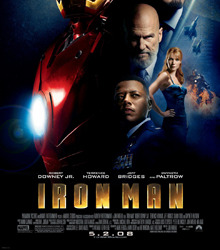
In 2008, Jon Favreau brought us Iron Man. It is the film that begins it all. Tony Stark, the callous billionaire playboy, is kidnapped by a terrorist cell following a demonstration of Stark Industries’ premier artillery, the Jericho. In captivity, Stark realizes that his company’s weapons are the very ones being sold to terrorist groups and used against the innocent. Following his escape, Stark works to move away from Stark Industries involvement in the US Military complex, and strive to focus more resources in the development of the clean energy. The MCU kicks off with a critical eye towards how the United States develops and trades weapons, making the third act’s villain a fitting climatic foe. Who pushes the hardest to build and sell weapons regardless of the outcome? Why Jeff Bridges’ Obadiah Stane, the Iron Monger. Phase 1 of the MCU sticks fairly close to this critical eye. The Incredible Hulk is hunted down by the US military so they can continue to use him for R&D as they develop their machine. Even Captain America is initially used as a propaganda star before being deployed in the fray of WWII. The question of how the US develops and employs its military resources is largely front and center. And then Phase 2 moves forward with hesitancy and reticence.
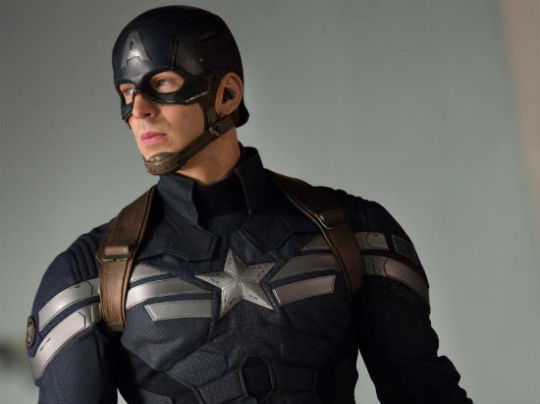
Captain America: The Winter Soldier was the Russo Brothers’ premier endeavor in the MCU, and it thrilled to no end. A phase and a half later, it still arguably remains the MCU film with the tightest plot and the best cinematography. However, the film sets itself up to be a critique of government surveillance in the name of security which, in 2014, was as timely as ever following the Snowden revelations of the previous year. Then the major plot twist of the film (albeit a fantastic one) shifts that critique on a dime. The reveal that HYDRA had been infiltrating SHEILD for decades and into its top tiers of administration comes the revelation that the expanded surveillance measures being pushed are part of a fanatical Nazi-remnant conspiracy. One could argue the ethical issue presented in Winter Soldier becomes moot because it was never truly a “US initiative” in the first place. Captain America’s suspicion and claims of what is “un-American” are shown to be just that: ploys from outside interests and foreign powers (sorta). Joss Whedon’s Avengers: Age of Ultron is blip on the radar. Stark wants to increase global security. Capt adamantly disagrees. There’s a virus that creates Ultron. Chaos ensues. Stark kind of looks like a failure. It seems in that moment that Stark’s desire for increased surveillance (oddly similar to the HYDRA conspiracy in Winter Soldier) is proven misplaced. The Russo Brothers continue to play with that thread in Captain America: Civil War. The Sokovia Accords place the Avengers under United Nations oversight and require the registration of individuals with enhanced abilities. Stark, who is continually trying to find effective ways to save the world (and protect it from… well… the Avengers) signs without hesitation. Steve Rogers has his ethical qualms, but the story soon forgets the Accords as it becomes far more focused on the capture of Bucky Barnes, as well as the assassination of Tony’s father Howard Stark. The tensions between Captain America and Iron Man coming to a head monopolize the run time. By the film’s final act, the Sokovia Accords are all but forgotten, and with it the ethical question of government control and oversight.
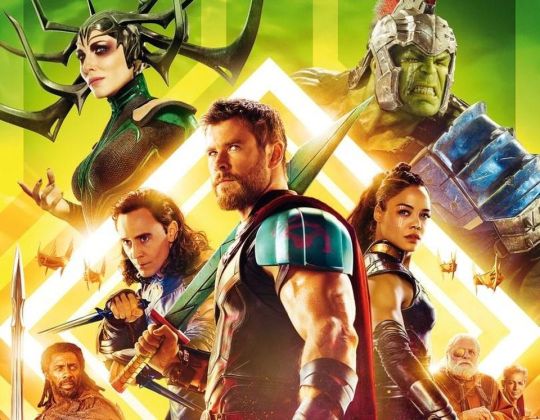
Phase 3 did bring some note worthy films that rub against this trend (a trend arguably strongest in the work of the Russos). Guardians of the Galaxy: Vol. 2 and Thor: Ragnarok wrestle with the legacy of colonialism. Starlord learns he is the son of Ego the living planet. Ego took a sexual partner on every world he visited in the interest of planting a literal seed to consume and transform that world. Thor is faced with the reality that Asgard, the kingdom to which he is heir, was built upon the violent conquest of other realms and the exploitation of his older, imprisoned sister Hera. Ragnarok’s final moments are poignant. The only way to save the people of Asgard and defeat Hera is to literally burn down the system and structures that were built by his father Odin. Taika Waititi has crafted a clear opinion on what it takes to remedy the legacy of empire. Destroy the structures and save the people who inhabit them. I think it is particularly brilliant and stands out as shining gem of a movie in the MCU. And, of course, there is Black Panther. While Guardians Vol. 2 and Thor: Ragnarok examine colonialism and empire, they do so in traditional fantasy/sci-fi fashion. With the distance of a world that is galaxies or realms away, the setting never so close to Earth as to make the analogue too obvious. Black Panther has no such distance. This is the film with what may be the most critical eye in the MCU. Woven throughout it are discussions of race and heritage, of violence and oppression, and of the shortcomings of isolationism. There are many far better equipped who have written about these themes in detail, and you should definitely track them down. For the purpose of this piece, it is important that Black Panther takes the questions of legacy, power, and resources, and plays them out on screen. It is fought out in the philosophical battle between Erik Stevens and T’Challa. It is a discussion that T’Challa takes directly to the land of his ancestors to insist “You were wrong!” The themes of resources and empire present in the first Iron Man and in Thor: Ragnarok are turned up to 11 in Black Panther. It is the only film in the MCU where the antagonist’s perspective and philosophy fundamentally shifts those of the protagonist. T’Challa will forever be different kind of king, a king unlike any previous king of Wakanda, solely because of Erik Stevens.
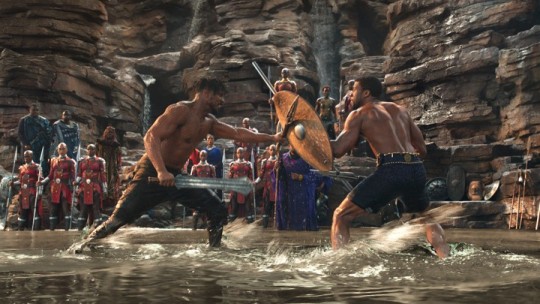
And yet, I can’t help but wonder. Why is the film with the most critical eye the one where the protagonist experiences the most concrete transformation of character, the one that is predominantly concerned with people of color? Why is it an African kingdom that experiences such a radical change in its philosophy of leadership? As previously noted, any conversation of the sort related to the US in the previous films is either made moot or overshadowed by the interpersonal conflict in the Avengers team. Following Black Panther was the much anticipated release of the Russo Brothers’ Avengers: Infinity War. I wrote about Infinity War on this blog before, and hoped for the Russos’ to set forth an answer to Thanos’ philosophy of resources and his theology of scarcity. The film ends with the infamous Snap. We watch as half of the life in the universe turns to ash before our eyes. It is tragic and the original Avengers team is left speechless.

It is tragic. And yet, the Russos found it fitting to have the Avengers employ the same tool in their defeat of Thanos. We see the same visual effect as the enemy is turned to ash. While one could argue for this moment of desperation, it is perhaps the one act that Tony Stark shows the most confidence in performing. And the rest of the world praises him for it. The ethics of the decision do not register on the Marvel radar. Once again, Avengers: Endgame was a wild ride I enjoyed watching, but its ethics of war and empire come up short. Apparently it is not the existence of a weapon that is problematic, just the one which uses it. And now the Universe once again faces Thanos’ scarcity question… At least the world is saved I guess. Read the full article
0 notes
Text
Unintended Symbols: Minor Spoilers for Joker (Part the First)

It's Academy Award season! The nominations are announced! Between now and February 9, ThePilgrimGeek is going full Blockbuster clearance shelf with Minor Spoilers! What made me laugh? What made me cry? What were the films that stuck in my noggin for days? Here's the first of Minor Spoilers at the Academy Awards! Todd Phillips' Joker has been nominated for 11 Academy Awards, including Best Picture. For a director who’s works include The Hangover and its sequels, as well as Starsky & Hutch, it is an astounding and captivating change of form. The cinematography and writing is on point, and Jaoquin Phoenix easily delivers one of the best performances of his career. Joker, in most regards, is a well-crafted film. Yet, my response to Joker was a cocktail of curiosity, confusion, and more than a dash of despair. I walked out of the theater mulling over all I had watched, a telltale sign that this movie was worth the ticket and that perhaps the haunting sensation that followed me required my attention and prayerful engagement. In doing so I resolved that the only appropriate way to discuss Joker is in two separate Minor Spoiler reviews. This first installment reflects the part of me that is more generous with the film and what I think may be Philips’ commentary specifically about the Christopher Nolan’s The Dark Knight Trilogy and its cultural impact. The second part will approach the character of The Joker both in Joker and in the comic book canon of the DC Universe through a broader theological lens. With no further ado, here is my first of two Joker reviews : Unintended Symbols: Minor Spoilers for Joker I wonder what Joker would look like if there had never been Nolan’s The Dark Knight Trilogy. I even wonder if such a movie would exist if Christian Bale had never faced off with a painted Heath Ledger or a masked Tom Hardy a decade ago.
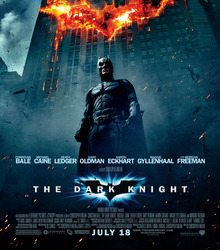
Christopher Nolan weaves one thematic thread throughout his trilogy: what does it take to create a symbol? From the first moment Bale’s Bruce Wayne conceives Batman, he has one aim. He tells Alfred “I want to be a symbol.” Becoming a symbol to the rest of Gotham City is Wayne’s endgame from the outset. He wants to inspire the citizens of Gotham to have no tolerance for the corruption and villainy of the city’s crime soaked streets and bought-and-paid for bureaucrats and politicians. Wayne continually questions whether or not the symbol is having the resonance for which he is striving. In one of the more humorous moments of The Dark Knight, Batman encounters copycat vigilantes with firearms trying to thwart the schemes of an escaped Scarecrow. Batman reprimands them with his fists and words. They accuse Batman with “What’s the difference between you and me?” The Caped Crusader responds “I’m not wearing hockey pads.” This is more than a mere comment about equipment. This is an indictment about the copycats’ methods under the symbol of Batman. This is revisited in the trilogy’s final installment The Dark Knight Rises. While Batman strove to emphasize what differentiates him from former mentor Ras al’Ghul in Batman Begins, he is now face-to-face with Bane, who calls his whole endeavor into question. If what Batman desired was to be a symbol to mobilize the masses for change, then the Dark Knight was not radical enough. Following Bane’s defeat, the symbol of Batman is passed on to a new Batman in the person of Blake. Batman as a symbol that inspires and mobilizes is at the center of Nolan’s take on the Batman mythos. And yet, the second installment, The Dark Knight, saw pop culture latch on to a different symbol…

In 2007, Warner Bros. embarked on a viral internet marketing strategy in the months leading up to The Dark Knight's release. This included a mock campaign site for Harvey Dent and a "vandalized" duplicate site in which fan emails revealed (pixel by pixel) the first look at Ledger’s Joker, and multiple scavenger hunts launched via the website WhySoSerious.com that led to more Joker images and a teaser trailer. These and other viral strategies put the enigmatic image of the Joker, and his line “Why so serious?” further into the pop culture ether. This strategy was adjusted and refocused on Harvey Dent (Two-Face) following Ledger’s untimely death prior to the film’s release. Despite this transition in marketing, the iconography of The Joker became far more associated with The Dark Knight, perhaps even more so than Batman himself. Even a decade later in 2019, despite having the introduction of two more silver screen Jokers, Halloween brought more kiddos and adolescents in the guise of Ledger’s Joker asking for candy, rather than that of Jared Leto or Jaoquin Phoenix. Undoubtedly, Nolan and Ledger created a definitive symbol of the Joker that has persevered. The pop-culture obsession with the Joker was ignited in 2008. Between the viral marketing of Warner Bros, and Ledger’s iconic performance (which eclipses Bale’s Batman), the real symbol to rise was from The Dark Knight was not the virtuous Batman, but the chaos-relishing Joker.
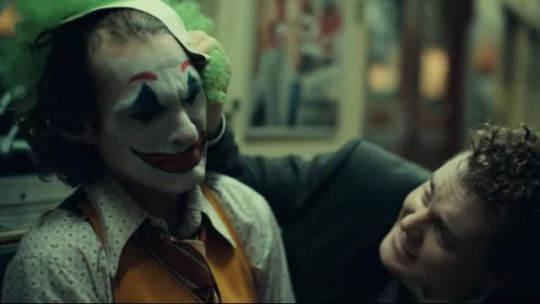
In light of the pop-culture impact made by TDK, I think it is more than coincidence that in Todd Philip’s film, Arthur Fleck’s murder of three drunken, abusive frat boys while in clown makeup take on in-movie cultural significance. In Joker, the image of the clown becomes the icon under which the disenfranchised of Gotham unite. The image’s power is only fueled by the rhetoric of the city’s elite, namely the Caped Crusader’s own father, Thomas Wayne, who uses "clown" as pejoratively in reference to those praising the mystery murderer. And it is under the icon of the Joker that society breaks out into chaos. In the film’s climax, Arthur Fleck (painted and garbed in what is recognizably the figure of Batman’s arch nemesis, insists to Robert DeNiro’s Johnny Carson-esque late night host that he never meant to be political. Any association between him and the growing symbolism of the clown, he claims, has little to do with him. However, he then goes into an extended socio-political speech that culminates in him killing the late night host. It is the moment that literally sets Gotham on fire as the masses don clown masks and paint, rioting through the city. For a character who does not desire to be a symbol for the politically disenfranchised, he rages against all that the forces that (insofar as Fleck is an unreliable narrator) seem to be oppressing the downtrodden of Gotham.

Fleck has many moments where he basks in the presence of the symbol, grinning at flyers of killer clowns and looking gleeful over news headlines. The film’s near final moments sees the Joker dancing on the hood of a wrecked police cruiser while chaos reigns around him. He is basking in the madness. So the questions remains: what does Arthur Fleck’s Joker stand for? What is Todd Philips’ portraying? At best, maybe Philips is portraying why the iconography that grew around Ledger’s Joker following The Dark Knight is an empty one, offering not hope but only chaos. Maybe we are asked to look at Arthur Fleck, to paraphrase Michael Cain’s Alfred Pennyworth, literally watching the world burn and dancing in the fire light, and ask: what good is there in the cultural popularity and idolization of the Joker?

If Phillips is attempting to draw out this question in a sort of satire of the The Dark Knight's Joker, then we should ask if Philips does this well. If at any point the chaos and violence that Fleck incites (from whatever motivation) is justified or even glorified in its portrayal, then Philips has failed. A satire done poorly is no satire at all, but instead becomes the very object that is meant to be satirized. Maybe Philips has only added to the cultural iconography of the Joker. I think that Tasha Robinson, writing for the Verge, is correct in the assessment that “Phillips suggests in the end that everything he went through was necessary to bring him the power and recognition he deserves. It’s a tempting fantasy, crafted with utter conviction.” Phillips' satire fails, if that was ever his intent. But perhaps the Clown Prince of Crime is not a force to be satirized. Perhaps any time the Joker becomes a symbol, or is transformed into an icon, there is only one result: the celebration of violent chaos. Perhaps he is not, and was never meant to be, a symbol on par with Batman. Unless Todd Philips understands that too… but let’s cross that bridge to Gotham next week. Read the full article
0 notes
Text
That Time My Therapist and I Talked About Eating
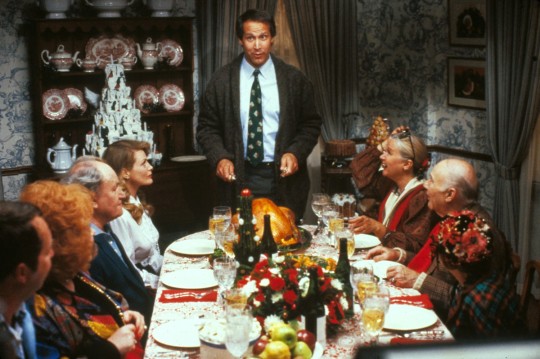
My therapist and I working on my relationship with food. We’re working on my relationship with food because, frankly, it has been a dysfunctional one for at least 20 years. For years, I was aware that I ate compulsively for a sense of comfort. It wasn’t uncommon for me to order a whole pizza and mozzarella sticks, then eat it in near masturbatory fashion. I inhaled food. And for as long as I can remember, I ate my food extremely fast. Whole courses disappeared minutes after they met my plate. As I explained this phenomenon to Dr. P, he said “If you were truly eating for pleasure, you wouldn’t eat so fast. Do you taste your food?” I can only recall one meal I truly savored, that I ate slowly and thankfully. I ate this meal at a convent for a retreat, and I ate it in total silence. I can’t tell you what I ate, but I can tell you it was the most pleasurable meal I have ever eaten. Here is the irony of my food eating dysfunction: I eat compulsively as a soothing activity, yet I do not eat slow enough to experience the very pleasure I desire for the purpose of soothing. Dr. P knows my profession, my education, and my faith. It is no secret to my therapist that I am an active, observant Christian. And it is no secret to me that he is not a person of faith in any regard. My therapist’s second question was “Does anything in your faith tradition prohibit you from taking pleasure in food?” I surprised myself with my emphatic “No,” I said, “In fact, it calls me to the exact opposite.” There is one meal I eat slowly, and savor each week. Each Sunday, I hear the priest say “Christ our Passover is sacrificed for us.” Then, with a multitude of others in one voice, I respond “Therefore let us keep the feast!” I walk to the front, kneel to received a white, near tasteless wafer, and I let that wafer rest in my mouth as I wait for a sip of wine (port no less!). I make the sign of the cross, stand, and savor the taste of that wafer and wine as I return to my. I let the taste of the Eucharist linger, wishing the sensation would never cease. At Dr. P’s question, I realized that I eat the holiest of meals, that served at the Communion table, as if it is the most perfect meal. I eat as if time stops, as if Christ wants me to rest and enjoy. Such a way of eating is galaxies apart from how I often eat my day to day meals, meals that carry physical nourishment (save for the aforementioned pizza). I do not eat every meal as if it is a blessing or provision. I certainly do not eat each meal as if it is a taste of Heaven, a respite from the chaos of the world. I forgot to mention Dr. P’s follow up question: “If you are eating so fast, where are you trying to go? What are you trying to do? Why the hurry?” Good question. I do not know. There is an image present in many of the legends and myths of the ancient world in the western hemisphere. It is present in tales such as Beowulf and the Arthurian romances, and is echoed in the works of Tolkien. The image is the hearth. In many stories, the Hero arrives to the village or kingdom on his or her way to defeat a great evil, often some monster that plagues the population. The night brings chaos. Yet the chief or king welcomes the Hero to his hearth and fire, and there is feasting.

The image carries contrast: the darkness of night is full of cold and chaos. It is a space of danger and fear. But around the hearth, in the glow of firelight, the village rejoices and celebrates the guest. The darkness is forgotten, if only for a moment, and everyone eats and drinks without anxiety, without hurry. The hearth reflects hospitality to the traveler, and respite from the cold winds of the abyss and unknown. The Communion Table, with its invitation to come and receive nourishment and the hope of Christ, is much like the hearth which welcomes Beowulf, or Sir Galahad, or Bilbo Baggins. “Give us this day our daily bread.” Every week, sometimes more than once, Christians around the world say these words as part of the Lord’s Prayer. As a person with plenty in the scheme of things (I do travel each week to a grocery store and choose my food), “daily bread” can be said and quickly forgotten. But to Jesus’ first century listeners (people who fished, baked, and bartered for their supper) giving thanks for daily bread was to acknowledge that each bite was a blessing that was not guaranteed to be there tomorrow. A meal eaten in thanksgiving is eaten in a way that lingers and savors. What if I ate each meal as if it was the Eucharist? What if I chewed to taste and be thankful? What if I let each bite rest in my mouth because for the moment, the chaos and the anxieties of the world are set at bay by the hearth and table set by my God? Several weeks ago, I ate two Thanksgiving dinners as my wife and I visited our families. I tried it. Did you know turkey could taste so juicy, or stuffing so rich, or pie so sweet? The Psalmist sings that the Lord sets a table in the presence of the enemy. To eat, to give thanks, and to pray for daily bread, is to see each meal as Christ calling me to rest from the busyness of my day. Read the full article
0 notes
Text
What Saladin Ahmed Gets About Evil
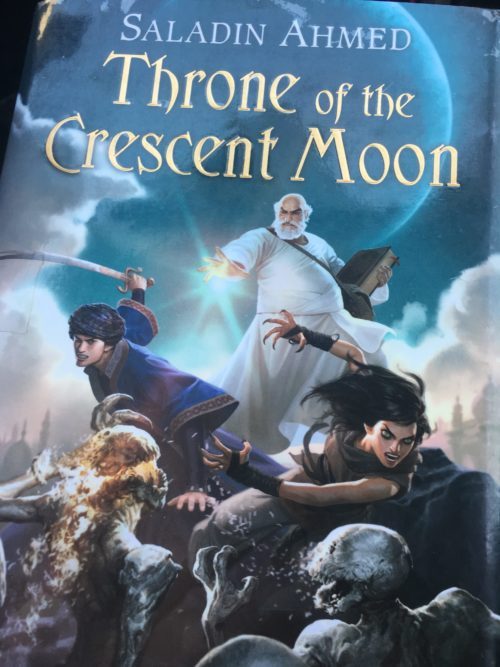
In February of 2017, I posted Imagination for Resistance: An Incomplete Pseudo-Syllabus. In it, I set a lofty goal of reading and sharing theological works and genre fiction created by voices in the margins. My intent was to devote 2017 to that project, and I failed miserably. You may have noticed that the post still refers to the blog as Noggin Squall, certain hyperlinks no longer work, and I even mislabeled the genre of a book on my reading list. I also included Gene Wolfe on my list under the pretense that he is an excellent writer. In hindsight, his inclusion undermines the very premise of the project. There are many places to share my love of Wolfe, but a series on genre writers that are not white men is not one of them. Bad form, Dan, bad form. But with seminary finally over and a new career on the horizon, I dove into the book at the top of the list! If you're a fantasy buff, I highly recommend Throne of the Crescent Moon by Saladin Ahmed.
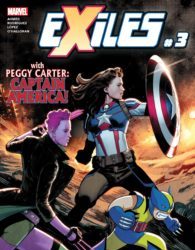
https://www.marvel.com/comics/issue/67337/exiles_2018_3 Readers of Marvel Comics will recognize his name. Ahmed made his mark in the comic book world with his recent run on Black Bolt, and he is currently writing Exiles as part of the Marvel relaunch, Marvel Legacy. (I just recently added Exiles to my pull list and tracked down its back issues). Ahmed is also a poignant and humorous voice to follow on Twitter. The modern fantasy genre is nearly defined by its Western, Medieval European aesthetic. This should be no surprise given that the granddaddy of modern fantasy, J.R.R. Tolkien, was a fanboy Celtic and Nordic mythology. Even today, Martin's A Song of Fire and Ice, while exploring medieval politics on a larger, geopolitical scope, is predominantly concerned with the land of Westeros with its knights, peasants, and competing pale-skinned kings. The opening pages of Throne of the Crescent Moon establish that this is not that sort of world. Instead, the reader is introduced to Doctor Adoulla Makhslood who is drinking spiced tea in city of Dhamsawaat. It is a bustling metropolis full of economic disparity, systemic oppression, and a brewing revolution just beneath the surface. Adoulla is an aged ghul hunter, looking to retire from the swashbuckling life of fighting the servants of the "Traitorous Angel." Yet events occur that take him, and his sidekick Raseed bas Raseed, into a conflict of cataclysmic proportions. It is a fantasy novel as informed by Ahmed's heritage and Muslim faith as Tolkien's is informed by his Roman Catholicism and decidedly English heritage. In a 2012 interview with ThinkProgess, Ahmed spoke at length about his writing process, the book's reception from both secular and religious readers, and his thoughts on the legacy and trajectory of fantasy. Ahmed described Throne of the Crescent Moon as a "very Arab-American novel in the mix of mythology that’s in there." I'm hesitant to dive too deep into speculating or assuming the ways in which Islam influenced Ahmed's story and world building, lest I presume too much or risk appropriating his theology for my own purposes. I am student of Protestant Christian theology, and my knowledge of the Koran and the diversity of Islamic thought is admittedly lacking. Yet, there is one element in his work that I recognize from our faiths' shared Abrahamic heritage: Evil cannot create, it can only corrupt that which is already created. The forces of Evil that plague Dhamsawaat and the surrounding region are largely mysterious. The characters refer to those who serve the "Traitorous Angel," but the Traitorous Angel remains in the background, a malevolent being often referenced but never seen. Unlike Tolkien's Sauron, whose location is known and whose forces are creatures who seek destruction from their birth, the Traitorous Angel is an obscure, near mythological character who is only recognized through the work of its servants. Whatever this cosmic opposition is, it is beyond the scope of Adoulla's mission. The ghuls and those who create them are the Doctor's concern. The ghuls are creatures created from human corpses, sand, and insects. They look human, but are without free will and act the behest of their human conjuror's magic (a necromancy of sorts). For the majority of the book,
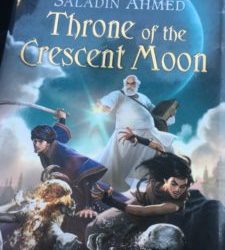
the reader never encounters the humans responsible for these monsters. However, Doctor Adoulla reminds the reader often that they are human bodies murdered, exhumed, and desecrated for the purpose of evil. The presence of evil is most evident when it perverts and twists the humanity of another person. This is only further exemplified as Ahmed describes the economic disparity and oppression that is pervasive throughout Dhamsawaat. Evil is not on equal footing with the Divine Good, but it is a corruption of that which already has been created. The fantasy genre, and particularly those works written by western Christians, often portray the conflict of Good and Evil in a Manichean dynamic in which forces of light and forces of darkness are in a dualistic conflict. They are portrayed as equals in power and ability. In the West, the resolution is often that Light eradicates the Darkness. This dynamic is present in Tolkien's The Lord of the Rings to some extent, although his experience in World War I may be reflected in the impending shadow of Mordor. But Tolkien's Orcs and armies of Sauron exist solely for evil means. (It should be noted that there is more nuance to the nature of Evil in Middle-earth, but that is predominantly found in The Silmarillion). The ghuls in Throne of the Crescent Moon and the mysterious humans who create them reflect a fundamental truth of reality that fantasy stories often lack. Evil is made known through its corruption of human beings and of Creation. In the narrative of the Hebrew Scripture, and specifically from Genesis 4 through Samuel and Kings, there is no Satan mentioned. No abstract evil is personified and made manifest so that warriors of righteousness can slay it. Instead, the murder of Abel at the hands of Cain marks the beginning of the biblical text’s assertion concerning the nature of evil in our reality. Regardless of whatever Satan or demonic forces that may lurk behind the veil of the material world, we know evil most clearly in the hurt and dehumanization inflicted on our fellow human persons. Let me say it one more time: Evil is most evident when people are treated as less than human. And that, friends, is what Saladin Ahmed gets about evil. And I look forward to reading more of it in his worlds of fantasy to come. Read the full article
0 notes
Text
Avengers Finite War- Thanos and the Theology of Scarcity

I hope that by now the majority of you have watched Avengers: Infinity War. Some are praising it, some are less impressed. At the end of the day, the most I'll say is this: it is a cinematic feat to have produced a whole series of films over the course of a decade that culminate in a climactic feature-film conflict. My mind is blown by that alone. Overall, I enjoyed the movie. It nailed many of the characters interactions I was dying to see. The banter between Thor and the Guardians of the Galaxy was a treat. Watching Doctor Strange and Tony Stark compete for the Alpha role contrasted how far different each of them has developed, despite having near laughably similar origin movies. But most reviewers agree that the narrative arc of Avengers: Infinity War is concerned almost exclusively with the Mad Titan, Thanos. Thanos' quest for the complete collection of Infinity Stones (glowing rocks that together grant omnipotence) stems from his desire to bring balance to the universe. Thanos witnessed the poverty and famine that took place on his home planet, and resolved to indiscriminately wipe out half of the universe. In doing so, Thanos believes that the universe will now have enough resources for the living half to flourish without lack. Many a film reviewer has praised Thanos for his complexity of character and motivation. The Mad Titan appears as one who is solving a problem via the most logical means. The villain's Malthusian inclination creates a bizarre quest to save the universe.
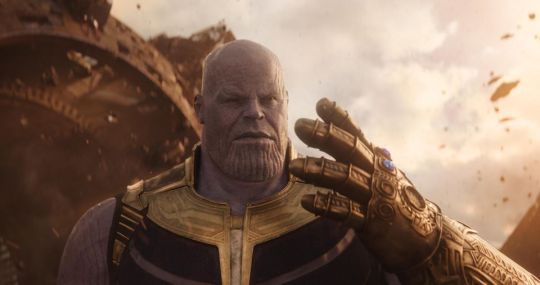
The kicker of Avengers: Infinity War is that Thanos succeeds. The film's closing moments are set into motion by the iconic snapping of his Infinity Gauntlet-clad fingers, and half of existence is extinguished. It is truly tragic (albeit rather light on the despair when you read the MCU release schedule). Thanos wins. Not only does he win in accomplishing his quest, he wins the argument. The discussion is his because no Avenger engages the ethical conundrum beyond "No it's wrong to kill millions of people!" The Avengers have no way to refute Thanos' philosophy because they too are living by a theology of scarcity. Even Captain America, for all of his virtue and integrity that has wrestled with the like of SHEILD and Tony Stark, has few words throughout the whole movie. So what is a theology of scarcity? A theology of scarcity asserts that all resources are finite, and that there is not enough to sustain the flourishing of humanity and creation. The remedy to such a theology is a theology of abundance: God has imbued Creation with enough to go around. When we adopt a theology of abundance, we give generously from our own stores, knowing that God will provide more, because God provides for us. Abundance is woven throughout the biblical text. Walter Breuggemann wrote about it far more eloquently than I can. As Breuggemann observes, it is prominently illustrated when Jesus' feeds the four thousand in Mark 8. Thanos' theology of scarcity is all encompassing. It is how he sees all things. His binding of Eitri's hands and extinguishing of the forge at Nidavellir reflect that he views power as a limited commodity. The last object forged must be his Infinity Gauntlet. And at an integral moment, Thanos confesses that he loves his daughter Gamora. Yet, because she is the only person she loves, she must be sacrificed so he may obtain the Soul Stone. While Thanos and his lackey Ebony Maw claim that all are "children of Thanos," Gamora is the only one whom he says he loves. His treatment of the sisters Nebula and Gamora has only differed in one way: Nebula has received cybernetic implants a her penalties for losing duels with her adoptive sister, Gamora. The duels were demanded by their surrogate father, Thanos. Thanos views love as another commodity ruled by his theology of scarcity. When discussing resources and scarcity, there is much to be unpacked. The global situation is one of hunger and poverty. Ethical questions concerning the use of natural resources abound. And some will be quick to say that certain economic models find their foundation in either a theology of scarcity or of abundance. So much to talk about. Instead I will ask what many film goers have asked: What will happen in Avengers 4?
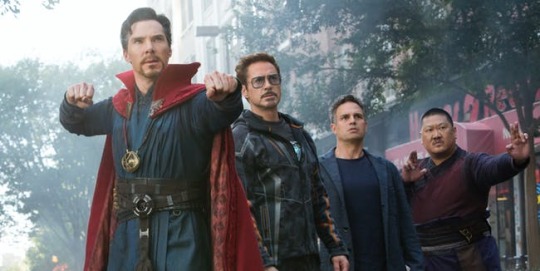
For my part, this is less a question of plotting and events. Rather, will Avengers 4 offer a counter solution to Thanos' climactic moment of victory? Once the mighty Avengers restore the universe, will they have an answer to the issue of galactic scarcity? Will we see the hope of the MCU hinge on a theology of abundance? I'm doubtful. Images of generosity begetting generosity not does a summer blockbuster make. If there is hope for such an ending, I see it in the arc of Dr. Strange. The Sorcerer Supreme who was charged with guarding the Time Stone at all costs, saw among 14,000,605 possible futures only one in which there was victory over Thanos. And he dies, handing over the precious artifact in order to save the life of Tony Stark. This was a stone that was so coveted and powerful that to lose it meant catastrophe. Perhaps Dr. Strange saw a future that could only be brought about when he no longer viewed the power as a finite resource limited to one green stone. Instead, I hope he saw that power was something not to be hoarded and guarded but to be relinquished. Perhaps we will learn that the Time Stone was a trinket compared to Stark's life, and it is the act of self-giving that will bring about the "balance" that Thanos so desired. Until then... I don't feel so good... Read the full article
0 notes
Text
How the Force Brought Me to Seminary
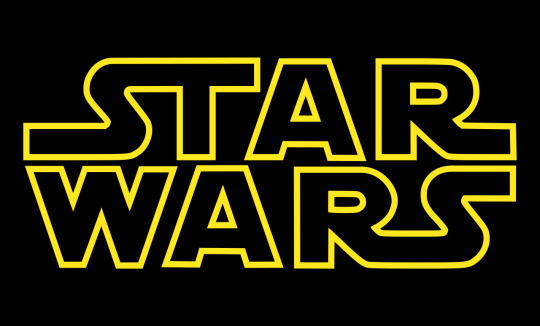
It is May 4th, friends! As in "May the Fourth Be With You!" For those of you who haven't quite caught on, the fourth day in May is Star Wars Day. For many fans with paid-time off to spare, this is a day watch all six movies in production, chronological, or Machete order. I will also be graduating from seminary this May. Very cool. Thus, it seems fitting that I share how the Force brought me to seminary. In 1997, the father of a close friend took my friend and I to see The Empire Strikes Back (Special Edition) at the local movie theater. The seats were stiff and musty. The floor was sticky with spilled cola from a decade earlier. It was everything I fondly remember about the movie theater experience before internet streaming and High-Definition video piracy prompted cinemas to up their game by mopping the floors and installing recliners. My friend and I sat in anticipation, our buckets of popcorn already half empty. After several trailers, the blue print "A long time ago in a galaxy far, far away" quietly appeared, only to fade as the yellow text for the opening crawl burst onto the screen! John Williams' iconic score filled the room! My 8-year old heart pounded in my chest as I dutifully read the crawl, trying to grasp what it all meant!. This, friends, was the first time I had ever seen a Star Wars film in its entirety. And it was nothing short of life-changing.
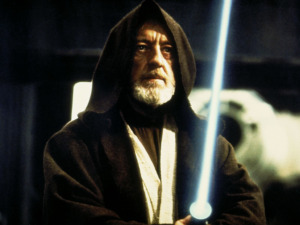
http://starwars.wikia.com/wiki/File:Ben_Kenobi_ANH.png The following Christmas, my parents bought me the Special Edition trilogy on VHS, and I watched those over, and over, and over again. I subscribed to the monthly publication, Star Wars Insider, to stay on top of the latest cantina chatter from a galaxy light-years away. I even had the official fan club membership card. Thus I quickly moved into the world of Star Wars fandom, learning all the fun and inconsequential trivia that often leads folks watching the movies with me to say "New rule. No more talking during the movie." I immersed myself in this other world. I read the novels and comic books. I borrowed various editions of Essential Guides to Star Wars and learned all the histories, biographies, and technology behind George Lucas' epic space opera. And I was captivated by the Force, and the Jedi Order. I could write a post devoted just to the Jedi Order with all of its virtues and vices, but not today. Suffice it to say, the Jedi were a mysterious clan of space wizards who followed the way of some mysterious space energy. Cool enough. Yet these Jedi had a master-apprentice structure. One did not simply become a Jedi. There was training, and studying, and mentoring. And this was a new idea to me. I grew a deep desire to be mentored in the ways of the Force (sorta). The late 90s and early 2000s were the hay day of Evangelical youth ministry in the USA. A church youth group could attend a youth conference once a month if they could afford it. For every secular band a kid enjoyed, there was an alleged Christian music industry equivalent. The Evangelical youth market even peddled a vast array of Bible verse-adorned graphic tees (I owned a dozen!). In the midst of all the superficial clothing, mediocre music, and dozens of altar calls at youth

https://www.christianbook.com/lords-gym-shirt-white-x-large/9128000072/pd/52004 conferences, I felt something was lacking. The Gospel as it was presented at these events offered no path of discipline or growth. The message was often along the lines of "Accept Jesus, and be saved from sin. And you will be changed." If there was change, most of my peers and I weren't always aware of it. Rather, we responded to alter call after alter call to accept Jesus as our personal Lord and Savior, waiting for the climactic transition into new life. For some, that has their experience. But for myself and others, it was an increasingly empty activity. For those of us who grew up in the church, or who considered ourselves Christians, there was little for us to do after "accepting Jesus into our heart." We were in the Jesus fold. Huzzah... So I watched, read, and dreamed about Star Wars and the Force. I fantasized of being taken under the tutelage of a Jedi Master, who would teach me to grow, to become more attune to the world around me and the cosmic presence that sustained it. I'm an extrovert, so in my adolescence I naturally sought out mentors, and I am ever thankful for those who took on that task. But my church tradition did not offer any element of personal training or discipline, no method of growing in my faith or in my sense of self. I knew that other religious traditions offered histories and catechisms for discipleship, but evangelical youth culture offered not such thing. The catechism for "growth" was limited to 1) don't sin, and 2) search out God's will for your life (for the record, I'm still waiting for a droid with a hologram, or an owl bearing a letter). I went college to study youth ministry, because I found youth group to be a safe place during high school and I wanted to facilitate safe spaces for others. Through God's providence, two classes touched my spirit where my deep love of Star Wars resided. The first class was a New Testament survey course. On the first day of class, the professor mentioned a name that I had never heard referenced when discussing the biblical text: Alexander the Great! I knew the name from high school history classes. I knew he wept when he conquered the known world. I never knew that his conquest helped set the stage for the culture and context that Jesus would be born into. The Bible suddenly ceased to be an isolated narrative culminating in Christ,
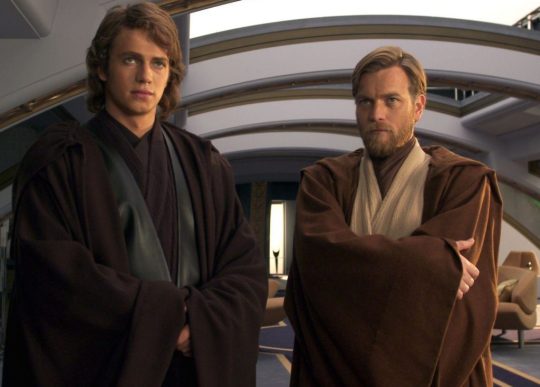
http://collider.com/star-wars-obi-wan-kenobi-solo-movie-update/#images but instead was now part of history. As the class, and subsequent classes, progressed, I found myself asking questions like "Who are the Chaldeans? What were their gods and worship practice like?" "What was the difference between a Pharisee and a Sadducee?" Or "What is happening in Palestine around the time Plato is writing his Republic or when Homer is conceiving The Odyssey?" The world of biblical studies opened up before me. The Bible captured a millennia worth of history (sorta.. we can discuss dating and historicity at a later time). And it was a history that was part of a global history of events. Not only that, there were languages to learn, and customs to understand. The biblical text was as captivating to my imagination as any obscure Star Wars character biography or mysterious Jedi tome. The same part of me that loved learning the intricacies of a mysterious galaxy far, far away jumped with joy to learn about God's relationship with a people in era far removed from my own. It was like discovering the world building enterprise of a master storyteller. The following year, I took a required course that introduced me to the world of spiritual formation. It exposed me to writers throughout the history of the Church who took on disciplines like fasting and whole variety of prayerful meditations. The mystics of the Jesus tradition were what I had been longing for over most of a decade. These men and women of God testified to the richness and compassion of a God who invited all to pursue him intimately, and in doing so discover more about themselves. These were the "Jedi masters" who knew the Great Master in a way I did not. And I could learn from them. When I graduated from college, all I understood about my future is that I wanted to learn more, and grow more. Six years ago, I enrolled in seminary. I agreed to take out the loans so I could learn more about the majesty and complexity of the Bible, as I had learned more about the galaxy of Star Wars. I sought out the classes on spiritual disciplines and spiritual formation because I wanted to become intimate with the great mystery that is Christ. I wanted to be challenged in my spiritual life, and beckoned into ongoing renewal. I wanted to know the Peace of God. Instead of Yoda and Obi-Wan Kenobi, I found Teresa of Avila and St. John of the Cross. Instead of a quasi- amoral Force, I found the person of the Holy Spirit. So the Force brought me to seminary, insofar that such an idea stirred up a thirst and longing for something I lacked. And the Holy Spirit was present in that stirring, and in that longing. I pray we all have such things stirred up in us, and I trust the Holy Spirit will meet us there. May the Force be with you. Read the full article
0 notes
Text
Barenaked Ladies Just Get Me

Barenaked Ladies just get me. And I don't say that lightly. I pride myself on being something of a journeyman wordsmith, and in that regard I find it grating when someone describes something he or she enjoys with nothing more than "They just get me." It sounds non-descript, unthoughtful, and inarticulate. Yet when an individual employs the phrase "they just get me," we grasp that person's meaning. Whatever the subject, it is evident that this person finds some transcendent resonance with a piece of art or another individual. Something mysterious about the subject that "just gets" touches the spirit and stirs the emotion in a way that other entities do not. The resonance is the mystery, so adjectives fail and the person can only resort to a statement verb portraying a relationship. "They just get me." So yes. Barenaked Ladies just get me. Maybe it is because I first saw Barenaked Ladies perform on Good Morning America in the summer of 2001. I was 13 and entering the 8th grade. I recognized the band's name, and I knew they had that hit "One Week," and couple others. But then I saw five pasty, white guys in glasses rocking like mad. They played the single "Falling for the First Time," off of their 2000 album, Maroon. It left an impression. Were they singing about failure? Were they filled with joy at the prospect of not being good enough at something? Were they singing about falling in love? Were they singing about some emotional tapestry composed of all these things and more? Whatever they were singing about, it was fascinating and catchy, and they looked like some distant cousin of mine. These were guys that I could imagine would want to hang out with me.Remarkable. I was hooked. As an young teenager who listened to mostly ska and awful Christian rock, seeing that the Barenaked Ladies were becoming a household name and frequently played on the radio was affirming. I, too could be a rock star. While my lack of rhythm and perseverance put a stop to that fantasy, it was encouraging to seeing guys that looked like me in the entertainment world who were not acting as the punchline to a joke. Throughout high school, I dove into their catalog, and was captivated by their eclectic lyrics. Some songs were dry and laden with snark, others were sarcastic but belied some real insecurities. And then there were the tracks that dropped all of that pretense and were naked and raw emotion. I listen now and can hear the echoes of a confession in songs like "Shoe Box," "Alcohol," and "Thanks That was Fun." Despite owning nearly a dozen albums by Weird Al Yankovic, and only 4 by BNL, they remain the only artists on my iPod that can set to shuffle and stay on for four hours. So here is my no-order-at-all, Top 10 BNL playlist... Falling for the First Time Pinch Me Bank Job Every Subway Car Brian Wilson Take It Back Maybe You're Right Golden Boy Light Up My Room The Old Apartment Be sure to check out their efforts to off-set their carbon footprint while touring. And here's some always welcome humor from Community... Read the full article
0 notes
Text
Teenage Wilderness: Purgation and Discovery of Identity in Napoleon Dynamite

What are you gonna give up for Lent, Napoleon? Whatever I feel like! GOOSSHH!"

Many of us have a movie dear to us that we feel best encapsulates or embodies our high school experience. For some, it is The Breakfast Club. For others, it's Superbad. And still yet for others, some logic or affinity leads them to Degrassi. Mine is Napoleon Dynamite. Most people seem to either love or hate Napoleon Dynamite. Shortly after its release in 2004, a church youth group leader made the comment "I don't why Napoleon is so cool now. We used to beat up kids like that when I was in school." Ironic, considering how many of us in youth group thought this film was fantastic. To this day, I love Napoleon Dynamite. (If you haven't seen it, or at least not in a while, give it a watch before you continue. I'll wait...) The understated, but definitive theme of Napoleon Dynamite is that of identity. Like many a high school story, this film is about learning to be yourself and no longer attempting to conform the popular, adolescent notion of "cool." Films like Mean Girls revolve around the main character's rise to Popular Girl status (or varsity athlete, or teen heart throb), only for said character to realize that such a social position in high school is not all glitz and glamor, relationships were damaged, and his or her reflection does not resemble "who I truly am." What follows is usually a climactic and impassioned "Be Yourself" speech at a school assembly or in the cafeteria. There's cheering and the mending of relationships, and probably a romantic kiss between the lead and love interest. I am not knocking those films (too hard...). I genuinely enjoy Mean Girls, because most anything Tina Fey

writes is comedy gold. But the narrative arc of such high school stories is formulaic and predictable. There is also a presupposition that everyone in high school wants to be in the in-crowd, and every lead is capable of joining it with the right makeover and compromise of conviction. Napoleon stands out in the homecoming crowd because the viewer knows from the outset that the title character will never achieve such in-crowd esteem. There is nothing in Napoleon's demeanor, conversational skills, or fashion choices that lend himself to a make-over trope. His attempts to impress are absurd. His claims include that he spent his summer in Alaska hunting wolverines, and that the school's "many gangs" want him to join because he's "pretty good with a bo staff." Beyond the school walls, Napoleon's older brother Kip chats with "babes online all day," and is an aspiring cage fighter. Most intriguing (and irritating) is their Uncle Rico, a thirty-something man who videotapes himself throwing footballs and constantly reminiscing about 1982 when he was a high school football star. Rico goes as far as to buy an alleged time machine off the internet. Each family member (save for Grandma) is out to define or redefine his identity. Ironically, Napoleon's two friends, Pedro and Deb, are not so preoccupied. Pedro may be navigating this high school in rural Idaho as a Mexican immigrant and ultimately decides to run for school president, but at no point does he put forth some facade or false self. Similarly, Deb may be quiet and shy when the audience (with Napoleon) first meets her, but from the start she is an aspiring business woman trying to save for college. Give credit where credit is due. How many high schoolers would start their own "Glamour Shots by Deb" in an attempt to achieve higher education? Both of these relationships are new to Napoleon, and I believe shape him into the confident person we see at the film's climax. "Napoleon becomes a confident person, you say?" Yes, I do say. The climax of the film comes not with a speech, but with a dance. This dance occurs, like many high school movie speeches, at a school assembly. At this point, the school presidential election speeches have both fallen flat. There's nothing about Pedro's speech that is dynamic. His tone is deadpan, and he advocates for setting up saints in the hallways to guard the students and bring them good luck. And his opponent, Summer Wheatly's speech is full of cheap fluff. Her skit has no substance, but Pedro does not have a skit prepared. Then Napoleon steps up. Napoleon's dance puts him in a place of voluntary total vulnerability. Not only that, the viewer knows he has practiced it. He has guzzled gatorade and sweated it out in his bedroom working on his sick dance moves because he found an instructional dance video in a thrift store. The climactic speeches in high school movies are always polished and well-articulated. It appears that Hollywood is under the impression that high school classes on public speaking produce orators who need no preparation, just the zestful energy of emotion and epiphany. Not here, good sir, not here. Napoleon's moment is one where rather than talking about some sweet skills he doesn't have, he demonstrates the culmination of his hard work and practice. And the dance does not occur because he has some revelation about "being who he is," but because his friend Pedro is in need. "Cute, albeit brief analysis, Dan. But what does this have to do with Lent?" Glad you asked, dear reader! It is fitting that many high school movies deal with identity. Adolescence is a time in which we desire to differentiate ourselves from the rest of the world, while paradoxically also desiring to be embraced socially by our peers (which we all do by various degrees). In the midst of my adolescence, I tried to be a guitar guy, because girls dig guys with guitars, but I had no rhythm. I tried to be a skater and practice on my friends' boards. But my center of balance was too high and I didn't handle the public humiliation of falling on my ass well. I'm sure we all have stories to share. But the desire to define our identity does not stop in high school. It may be reflected in the professional position we strive for or the car we buy. Our attempts at definition may be more evident in what we choose to post on social media (or even what we name our blog...). During Lent, some of us may need to let our preoccupation with the cultivation of our identities die. The Christian mystics described the threefold path of spiritual formation as Purgation, Illumination, and Union. For the season of Lent and the intent of this series, discussing Purgation is enough. Purgation is the process through which we are purified. It is how we learn what is infecting us and the beginning of how we are healed from it. The Christian Tradition has often understood the Wilderness as a place of death. It is where the Israelites are forced to wander for forty years, and it is where Jesus is tempted before he starts his earthly ministry. The Wilderness is a place of Purgation. And for many, high school is a wilderness. It is no coincidence that this movie is set in rural Idaho. Farmland is everywhere, and no character can escape it. Popular girls Summer and Trish are only popular at school. They live on dusty country roads, and Summer works at the local grocery store as a the checkout girl. They are all in this place together.

I believe we witness the purgation of Napoleon in Napoleon Dynamite. The change in Napoleon is subtle. Even after his performance, he still wears shirts adorned with unicorns, and he still draws pictures of ligers (duh, they're bred for their skill in magic!). Yet he no longer makes up stories about himself to seem tough, or badass. In fact, the farther we get in the film's runtime, the less Napoleon speaks. Napoleon discovers more about who he is when a) he is around people who care for him and enjoy his fellowship, and b) he has grown most comfortable in his own skin. At the assembly, following Napoleon's dance routine, the crowd cheers. And they cheer loudly. I believe they cheer for Napoleon's vulnerability, which reflects his newfound sense of self. For some of us, Lent may be a season for the purgation of the idolatry of striving for any particular identity. Maybe we need to learn to be comfortable with being nothing more than the person God created us to be. Read the full article
0 notes
Text
Love Lost and Rotten Cake: Lent and Great Expectations

I am a big fan of the work of Charles Dickens. Few writers of his era, or ours for that matter, wrote with such versatility. He could write satire, drama, and murder mysteries! He consistently wrote from the perspective of outcasts of society and about their interactions with the wealthy and elite. And he consistently and vividly described a Victorian England covered in grit, grease, and soot. He portrayed an England largely ignored by society's upper crust. While such a dynamic certainly brings to mind Dickens' Oliver Twist, my favorite work of his (second only to A Christmas Carol) is Great Expectations. In brief, Great Expectations is told through the eyes of Pip, an orphan who lives with his much older, abusive sister and her kind, blacksmith husband, Joe Gargery. Pip is selected to visit Miss Havisham, an older woman in a dilapidated house who only wears one shoe and an aged wedding gown. He falls in love with Havisham's adopted daughter, Estella. Once Pip is old enough to learn a trade and take on an apprenticeship, a mysterious benefactor
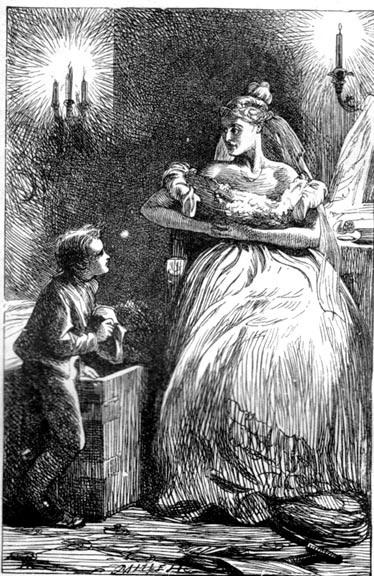
provides him with the money to become a gentleman. Pip assumes that his benefactor is Miss Havisham and that she is grooming him to marry Estella. However, Estella is coldhearted and spurns Pip's advances; she is more interested in entrapping another young man, albeit with the same cold demeanor. The mystery of the identity of Pip's benefactor remains, and his confusion and hurt abound. Misery, murder, ex-convicts: the plot contains it all. (Spoilers follow). There is much that can be said about this book and its wide array of characters, but for my purposes, I will only focus on the tragic figure of Miss Havisham. In her youth, Havisham was left at the altar and swindled out of her wealth. Unable to move past her grief, she lives in only one room of her house, wearing the wedding dress and surrounded by the same wedding cake and wedding breakfast, now decayed and a feast for insects. The clocks have even been stopped at twenty minutes until nine, the exact time she received the letter from her deceptive betrothed. It is out of her heartbreak that Havisham eventually raises Estella to be so cold, saying "I stole her heart away and put ice in its place." She continually works to emphasize the social chasm that exists between Estella and Pip, all the while encouraging Pip's suspicion that she is in fact his benefactor. To see where this ends, I encourage you to read the book. It's phenomenal. But for my purposes in this Lenten series, I want to focus on releasing that which is dead. Miss Havisham's character hinges on her inability to let go of her forsaken wedding day, and the end of her relationship with her betrothed. While she still wears her dress, the more appropriate image of her anger and bitterness appears in the cake and breakfast. The clocks may have been stopped, but time has marched on as the wedding feast has decayed and become
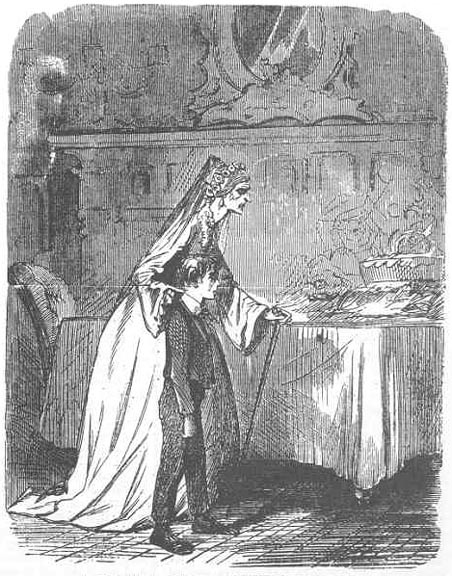
infested. It is rotten. There is no debate that Miss Havisham was once the wronged party, and was betrayed by her lover. But decades later, her grief has given way to bitterness. She herself has turned rotten with the wedding cake. And she now injures and betrays others. She deliberately seeks to break Pip's heart, and she has knowingly passed on the pestilence of bitterness to Estella. The observance of Lent beckons us to reflect on what pieces of ourselves are dead, while still desperately clinging to them. For some of us, these pieces may be relationships that are no more. Perhaps we fight to keep them alive in reality, or like Miss Havisham we keep them alive through bitter memoriam, refusing to accept that the wedding cake has gone stale, become infested with insects, and is now a hazard to our health. May our reflections on our mortality this Lenten season bring us to a place of release, freeing ourselves from the toxic grips of memories and relationships long since over. Peace. Read the full article
0 notes
Text
Lenten Stories: There, But Not There
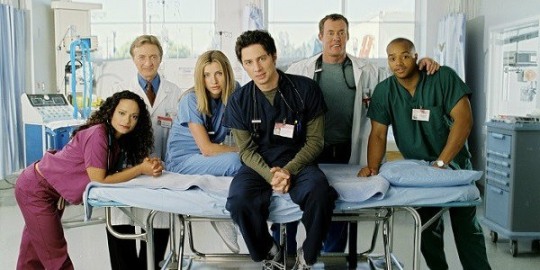
The death of a cherished friend or family member is truly an experience that is beyond description. Have you ever attempted to articulate the grief you feel at such a loss to someone who has never experienced it? All words fall short. It seems fitting, then, that God created in humanity a desire and drive for creative expression. Art of all sorts is what offers us a medium to express the inexpressible. If we want to begin to grasp the pain of losing a loved one to death, especially an unexpected death, art is where we do so. And it is through art we best explore our own mortality, conjuring images, sculptures, lyrics, and measures of music to give representation to that which is far beyond our understanding. Hence, my Lenten Storybook. It is a growing collection of narratives from various mediums which are meant to help us reflect, meditate on, and even battle with our mortality and the memory of dead loved ones. When a loved one dies, we are forced to face our mortality. I think this is no better illustrated than in an episode of the television series, Scrubs. For the uninitiated, Scrubs follows the lives of various staff members of Sacred Heart Memorial Hospital. The season 3 episode, "My Screw Up" (S3E14) features the return of Dr. Cox's ex-brother-in-law and best friend, Ben, played by Brendan Fraser. Ben made his first appearance in the series first season. In the season 1 two-part episode, Ben is

SCRUBS -- NBC Series -- "My Screw Up" -- Pictured: (l-r) John C. McGinley as Dr. Perry Cox, Brendan Frasier as Ben Sullivan -- Touchstone Photo: Carin Baer introduced as a goofy Brendan Fraser-type, always taking pictures with his Polaroid camera, and is diagnosed with leukemia. Skip ahead two seasons, Ben is back in town for the birthday party of Cox's son, and is in remission. (Spoilers ahead). When Ben tells Dr. Cox that he has not been receiving regular checkups, Cox tells the show's lead character J.D. to run some tests on Ben. J.D. protests as he is working with another patient who has an irregular heartbeat. When Dr. Cox returns, J.D. tells him he lost the patient to cardiac arrest. Cox is furious with J.D. and sends him home. Dr. Cox spends the ret of the day being followed around by Ben, who adds commentary and tells Cox that it isn't J.D.'s fault. In the background, preparations for the birthday party are looming. After working 60 straight hours at the hospital, Ben convinces Cox to go to the party and apologize to J.D. It is only as Ben and Dr. Cox arrive that J.D. asks Cox "Where do you think we are?" Ben disappears and the viewer realizes that Ben was the patient who died, and J.D. and Dr. Cox are attending his funeral, not a birthday party. Perhaps the most powerful and understated narrative device in this episode is Ben's Polaroid camera. It is with him at the episode's beginning. He's taking candids any chance he gets. But when he reappears after J.D. has told Cox he lost the patient (Ben), the camera has disappeared. The one item through which Ben engaged the physical world is gone. It's subtle, and is a detail I only caught on my fourth viewing. I think that it is no coincidence that the object associated
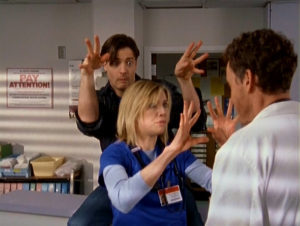
with Ben is one that captures memories and stills of history. Yet, when Ben was no longer around to memorialize the moments, Dr. Cox held on to his presence the most. "My Screw Up" is one of the best episodes ever produced in the series, and it is in no small part because the viewer is never made aware that Ben has died. He engages with Ben as he would any other character. Yet Cox is aware, because he never interacts with Ben in the presence of anyone else. Cox's interactions with Ben are similar to how one might interact with the photograph of a dead loved one. He converses with him, imagines responses, and even attributes a certain moral compass to his deceased best friend. I find that when a loved one near me dies, his or her memory occupies this weird space of "there, but not there." I instinctively expect to see him or her in the usual places. I periodically can still recall his or her voice with near perfect clarity. Shortly before Ash Wednesday this year, a friend of mine took her own life. She was in her early twenties, an astounding visual artist with a style all her own, and was a joy to be around. Such an unexpected tragedy stirs up far
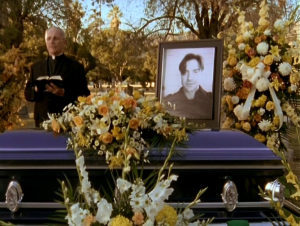
too many questions, most of which boil down to "Why?" I'm on the road a lot. My small car is where I do much thinking, sometimes too much thinking, and sometimes out loud. In the days after my friend's death was announced, I often envisioned her in the passenger seat of my car, and I would ask her questions. I imagined her answers. There was nothing concretely gained by this activity, but as someone with an imagination that takes on a life of its own, it became part of my grieving process. Perhaps some of you have handled death the same way. Maybe it has taken a picture or a headstone to encourage you to speak. Like Dr. Cox, we have a desire to speak with the dead, to resist the notion that material life comes to an end, even if only for a time. The space for grieving, the space for lament, the space that Lent lends itself to, lead us into a place of willingly embracing that which is there, but not there. Peace. Read the full article
0 notes
Text
Ash Wednesday: An Introduction to Lenten Stories

Almighty God, you have created us out of the dust of the earth: Grant that these ashes may be to us a sign of our mortality and penitence, that we may remember that it is only by your gracious gift that we are given everlasting life; through Jesus Christ our Savior. Amen. Remember that you are dust, and to dust you shall return. Last night, my wife and I had these words spoken over us as we let a person in a fancy robe rub ashes on foreheads. It is a yearly observance in many Christian traditions. You may have seen folks going about their daily lives, while their foreheads were adorned with sooty, cross-shaped thumb prints. Sounds a little ridiculous or ritualistically heavy? Good, because it is. And it is why the imparting of ashes remains one of my favorite rituals in the Anglican tradition. We are entering the season of Lent, and it begins with Ash Wednesday. The forty-day season is often commemorated by the giving up of something regularly enjoyed like chocolate, fast-food, or television. You can also find dozens upon dozens of articles online discussing the appropriateness or effectiveness of such seasonal deprivation. But more importantly, Lent is a time to reflect on our mortality, our finitude, and meditate on the liminal space that is death. It is not the cheeriest of seasons. It is fitting then that the season is kicked into motion with a vestment-clad person of the cloth telling you "Remember that you are dust, and to dust you shall return." You are mortal. And regardless of your theology, philosophy, or suspicion of what constitutes the afterlife, you will die. I will die. We all will die. And it is in the reflection of our mortality that we both grasp the mercy, grace, and overwhelming vastness of God. In some Christian circles, the meditation of Lent jumps too quickly to the Resurrection. It is almost as if we forget that Easter Sunday is 40 days away. New life is assured, but we rush to the empty tomb all too soon. We rush like children running to the light switch rather than letting our eyes adjust to the dark of our bedrooms and facing the shadowy manifestations head on. This year, Lent also falls on Valentine's Day. On February 14, 2016, I spent the evening sitting in a hospital room watching the season premier of the Amazing Race with my grandmother. It was the last time I saw her, and the last moments we spent together. That night, she faded in and out of sleep, but was conscious enough to ask me what she missed or to explain what the objective of a certain obstacle or game was. In those moments, she was as I had always known her. Then she died on March 2, 2016. I've written about her death on the blog before, here and here, so I won't elaborate too much, although the two year anniversary of her death is right around the corner. Losing a loved one makes us face our own finitude and mortality whether we have sought to do so or not. I think Lent offers the Christian tradition a season to face these things intentionally and with purpose, and to reflect and mourn for those who have left this life before us. I know I will be remembering my grandmother this Lenten season, and I will be remembering other loved ones as well. Some young, some old. In some cases, death was expected and even welcomed. In others, it seemed unjust and all too soon. In light of that, I will be exploring stories over the next seven weeks about death and mortality. Some may be obvious, others may surprise you. And I will pray for us. Please pray with me. Let us journey this Lent with heavy hearts, but also with outlandish hope Peace go with you, fellow pilgrims. Read the full article
0 notes
Text
The Fight I Wish I Started
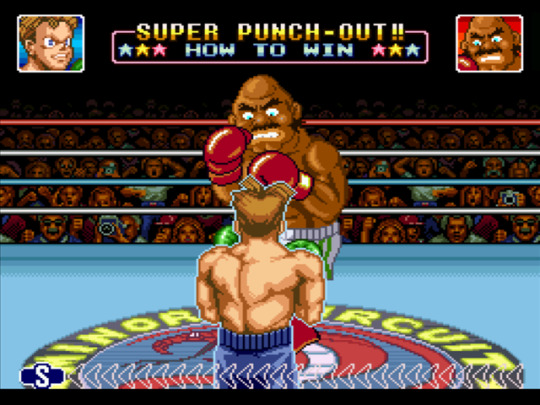
I have never been in a fight, not really. There were some close calls, to be sure. In elementary school, I was bullied for my rotundness. I passively endured, knowing that physically fighting would only result in discipline at school and at home. But at the start of my sophomore year of high school, and after having been the subject of an older student's heckling, vandalism and emotional abuse my freshman year, I did address the situation. I lifted him up by the shirt color, thumped him against a locker, and told him this was not how we were going to be spending this year or the rest of high school. He complied, left me alone, and by the time he graduated, we had even had a few friendly interactions. However, there was no scuffle or physical combat of any sort, aside from the 6 inches I elevated him from the floor followed by the sudden "bang!" of his shoulder blades lightly impacting the dilapidated locker. I have never been in a fight, not really. But there is a fight I wish I started. Let me set the stage. It was early March of senior year in high school. In New Hampshire, there was still fresh snow on the ground and several friends I'd known since I was 8 decided to stage a snow ball fight in the hall way. It was fairly premeditated (as most of their shenanigans were). They brought coolers from home to move the the previous night's precipitation and filled their lockers with fresh, heavy snow. I may have even volunteered my locker too. In my high school, we had a space called "Senior Square." There was nothing glamorous about this

space. It was nothing more than a large open area where the hallways met. Three walls of this square were occupied by the senior lockers. Very clever name indeed. 7th period wrapped up and students began milling about, off to their lockers to prepare for practice, the bus, rehearsal and the like. And then my friends opened their lockers. And the snow balls flew. Even those of us who hadn't conspired grabbed fistfuls of the cold stuff and vaulted them at each other. Many others joined in until some teachers and administrators broke it up. It was all rather harmless, albeit disruptive. The snowball throwing was over. And then this kid (I'll call him Lewis) walked by the Square. Lewis was a freshman, and he grew up with my younger sister. I never had any interaction with Lewis, but I knew who he was. Lewis was very large young man who always wore sweat pants and had a scent that gave away the fact that he did not maintain the best hygiene. I only remember seeing one friend with him; otherwise he was often alone, immersed in his Game Boy. The crowd had quieted down and had begun dispersing. I looked to see a friend of mine forming a snowball from what was the last of the snow in his locker. By this time, the snow was wet and even heavier, and he had formed it into a mass the size of a soft ball. I watched his arm extended and the packed ball of snow, now glazed in ice arced over our heads. I can remember it all moving in slow motion... The ball smashed against the back of Lewis' head as he was heading up the stairs. The snowball only broke into 5 pieces, stuck in his long, greasy hair. Lewis merely kept on walking until he was out of sight. Maybe he kept walking because the hallways of high schools have a current all their own which keep students moving along. Or maybe Lewis experienced enough abuse that a snow ball to the head was nothing abnormal for a school day. I only know the snowball hit him hard, and I can recall watching his whole head bob forward at the moment of impact. And my gut knotted up. I wanted to nothing more but to drive my fist into my friend's face for what he had done to Lewis. Lewis was not a a member of our social circle. He was not taking part in our shenanigans. Lewis was only trying to get to his locker and go home. Maybe he was longing to get away from the adolescent cesspool that, for many young people, is high school. Lewis was nailed with a snowball because he was there, he was different, and my friend was an asshole. I could have punched my friend, and looking back a part of me wishes I had. I wish I had decked my friend, and grappled with him right there in Senior Square, pouring out retribution for potentially ruining a veritable stranger's day. Yet, it would not have been retribution. It would have been revenge, and specifically revenge on my behalf, not Lewis'. How would splitting my friend's lip or bloodying my friend's nose have brought Lewis any comfort? At the very least, Lewis was already upstairs

packing his backpack and shaking snow from his hair. In those seconds, standing in Senior Square, I burned with the smoldering anger of hot coals. And those hot coals, left dormant for ten years, were ignited into flames as by a sudden draft at watching that snowball hit poor, unassuming Lewis. Every cry of "fat-boy" and every chorus of cruel laughter from grade school, echoed throughout my subconscious. I burned with anger, but at the time did not know why. Oh, to know what secrets we keep, especially from ourselves... As I reflect on this moment, I am struck by how much more humiliating this could have been for Lewis if iPhones had been as common a teen accessory a decade ago as they are now. Would the moment been captured on video and posted to YouTube or Snapchat? Would it have gone viral? Would thousands of teens, instead of less than a dozen, laughed at a snowball striking the unsuspecting Lewis? I cannot fathom the degree to which social media and smartphones have made bullying more pervasive and toxic. And I have no idea where to start. But today I prayed for forgiveness. Forgiveness both for my complicity in the snowball throwing, and for my my lack of objection. Forgiveness for my burning anger. And forgiveness for my lust for violence that would have served no good purpose. A lust for violence that would have healed no wounds, whether they be my wounds or Lewis'. And then I prayed for Lewis. I prayed that a decade later, he is surrounded by people who love him. I pray that he has embraced gifts and talents that maybe only he was aware of, and maybe those he is just awakening. I pray that life after high school brought far fewer bullies, and far more friends. Read the full article
0 notes
Text
A Resolution for 2018
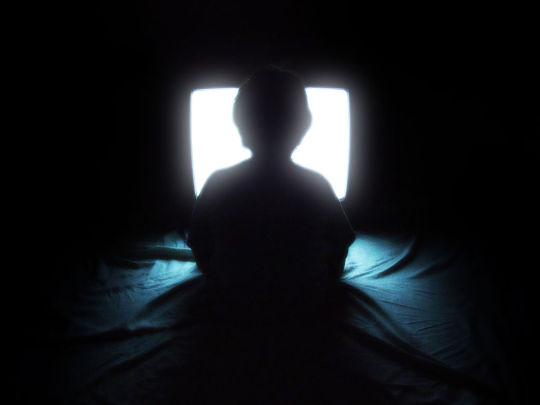
Happy New Year! I have high hopes for what is in store for ThePilgrimGeek in 2018. 2017 ended on a high note with the release of Rian Johnson's The Last Jedi, providing much grist for the nerd mill. (I've yet to discuss Star Wars here, but I may soon open that treasure trove). Black Panther and the next installment of Avengers are on their way. And there's always books to read, tv shows to check out, and last year's films to catch up on (looking at you, Baby Driver). I also have some creative writing projects that will become available for your pleasure along with a treasure trove of pieces by some good friends over at The Words Between the Worlds. And at the top of the heap that is positivity in 2018: my six-year slog through a master's degree will be completed in May. Woot! With all that said about all the new stuff to watch, here is my resolution for 2018: I will watch stories intentionally, and with purpose. The TV in my living room was on a lot in 2017. I used it to fill the empty stillness of my apartment when I washed dishes, or chipped away at homework. My Netflix queue continued to stack with various movies and shows that I knew were going to only serve as white noise. I'd catch myself watching a show that I didn't think was particularly well-written or produced, or was even that fun. More to the

point, I was not enjoying what I was watching. What wasted time. I could have been reading a new story I was excited about. I could have been writing a short story or fleshing out a novel with pencil and paper. I could have been sitting in a quiet living room, getting reacquainted with that shy and awkward, yet rejuvenating mistress called Stillness. Here lies the root cause for my resolution: over the past year, I have had a compulsion for noise. In 2017, I felt anxious without the chatter of voices blaring unintelligibly from my TV. Whether it be the stress of life or the cares of reading my news feed, I was afraid of quiet. I was afraid of quiet because it was in the presence of Mistress Stillness that whatever lay below the surface of my consciousness rose up. Fears, grief, exhaustion. To use stories as a numbing agent is a perversion of what I believe is the very purpose of Story. Stories are intended to give us words and imagery for our experience. The Greek myths of Zeus, Gaia, and Poseidon sought to interpret humanity's interactions with a chaotic natural world. Oliver Twist and Les Miserables depicted the plight of Western Europe's poor, who everyone had seen and heard for generations. Citizen Kane is hailed as one of, if not the greatest masterpiece ever captured on film, because the script, the acting, and the cinematography capture the tragedy of achieving material success and still finding loss and longing in ourselves. Story is a craft and art that stretches our imaginations, giving language to our deepest sufferings and loftiest joys.
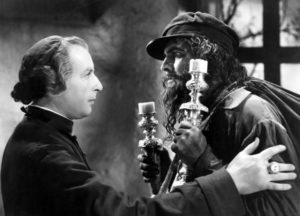
In 2018, when I watch a movie or a television show, I am committing to sitting down and actually becoming invested and moved by a particular narrative. Not scrolling through Twitter on my phone or checking email while it is on. I am giving myself permission to not watch a series because it is the talk of the town, and to not feel obligated to finish every show I watch. If I am three episodes in, and I am not drawn to into the world being built or the story being told, I will stop watching it. And finally, I will let Mistress Stillness have her time. If that time requires that I sort through parts of me that I have feared engaging then so be it-- because there's healing in the stillness. and there's healing in the right kind of story. In the story that moves us to tears, or makes us angry, or brings us elation. To watch something for the Joy of it is to watch intentionally and with purpose. But Joy is not present in the humdrum viewing of something that is "alright, I guess." Stories are gifts, and I want to enjoy these gifts to the fullest in 2018. Peace, fellow pilgrims. Read the full article
0 notes